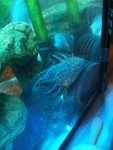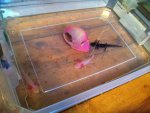Alkylhalide
New member
- Joined
- Feb 11, 2013
- Messages
- 993
- Reaction score
- 16
It has been a while since I posted my own thread here, mostly because I havent had any problems/issues that have arose in a while.
I am just wondering though if anybody has any tips on getting nice fluffy gills? Two of my axolotls(Echo and Texas) currently reside in a 25gallon tank together. They are almost 7months old and are 8" long. The tank is cycled, and I clean their poop out everyday/siphon every 3days and do a 20% water change once a week or more if need be.
They have a HOB filter (aquatech 20/40) with none of the filter media for it, I have discontinued the use of carbon because it was expensive and if I didnt replace it in time it made a huge mess. so I have the sponge that comes with the filter and crushed coral in a bag to help keep the PH over 7 (without it it was under 6) and then cut up sponge just to use up the empty space. I also have a sponge filter for a 30gallon tank in there as well. there is very little water flow I use a tuperware container lid to reduce water flow.
Their gills use to be big and fluffy, and I guess they still are okay, but they look like the gills never grew with them, they just grew into their gills, if that makes sense? like the gills have not shrunk but they havent grown either.
Any tips would be great. I also have 3juveniles in a rubermaid container and one has really big fluffy gills and the other two are just normal(guessing maybe genetics?)
I also attached a few pictures of my lotls. the picture of my juveniles is when I first got the rubermaid container, I have added more hides and a homemade filter to it since it will be their summer home(it is cooler there then anywhere else in my house, so I figured ill stay away from more stress if I can avoid it)
I am just wondering though if anybody has any tips on getting nice fluffy gills? Two of my axolotls(Echo and Texas) currently reside in a 25gallon tank together. They are almost 7months old and are 8" long. The tank is cycled, and I clean their poop out everyday/siphon every 3days and do a 20% water change once a week or more if need be.
They have a HOB filter (aquatech 20/40) with none of the filter media for it, I have discontinued the use of carbon because it was expensive and if I didnt replace it in time it made a huge mess. so I have the sponge that comes with the filter and crushed coral in a bag to help keep the PH over 7 (without it it was under 6) and then cut up sponge just to use up the empty space. I also have a sponge filter for a 30gallon tank in there as well. there is very little water flow I use a tuperware container lid to reduce water flow.
Their gills use to be big and fluffy, and I guess they still are okay, but they look like the gills never grew with them, they just grew into their gills, if that makes sense? like the gills have not shrunk but they havent grown either.
Any tips would be great. I also have 3juveniles in a rubermaid container and one has really big fluffy gills and the other two are just normal(guessing maybe genetics?)
I also attached a few pictures of my lotls. the picture of my juveniles is when I first got the rubermaid container, I have added more hides and a homemade filter to it since it will be their summer home(it is cooler there then anywhere else in my house, so I figured ill stay away from more stress if I can avoid it)



